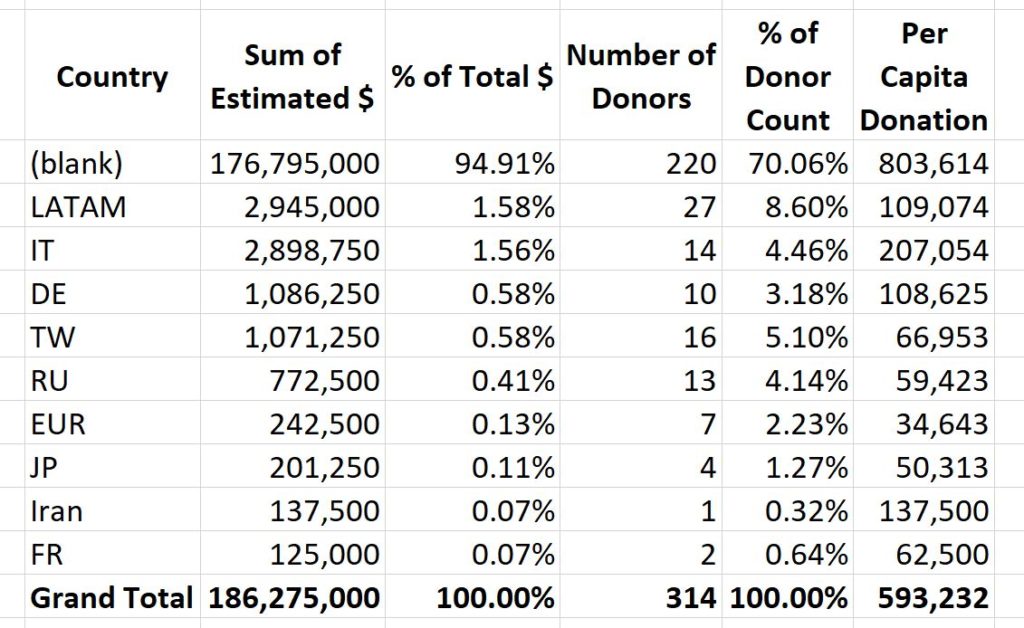
Key Findings
A detailed methodology is at the end of this post.
It’s important to understand that this is a list of donors that showed up to the Maiden Voyage event. It’s not an exhaustive list of recent IAS donors, and the list of donors is almost certainly smaller than the list of donors who get recognized at the big October IAS shindig which is usually held at Saint Hill in the UK. First, the absence of previously featured donors should most definitely not be used to “prove” that they may have decreased their involvement in Scientology.
Second, the list doesn’t have a specific time frame in which the donors reached their current status levels — the donations are cumulative, which means that some people may have reached a given status level after slaving away for a decade, and they may have only given 5% of the threshold amount to claim that status recently.
So when you don’t know the time frame for donations, it’s a really bad idea to compare this donor list to other donor lists, even from other Maiden Voyages. So we’re not gonna do that. We’re just going to use this list for what it can do well: tell us something about the composition of the donor population on this particular list.
The Biggest Whales
The first, most interesting thing to note is that uber-whale Bob Duggan doesn’t appear in the list. Tony Ortega reported in December that Duggan’s involvement had diminished, something we had previously heard from sources who knew him personally while they were in. We wouldn’t view Duggan’s absence from the “festivities” on the ol’ rust bucket as incremental proof of his having stepped back completely from the cult; we continue to believe, as we’ve said previously, that Duggan is likely using the foundation he set up to continue to funnel money from the cult in order to be left alone with his new non-Scientologist girlfriend and his likely retirement.
Second, it’s important to note the top-heavy nature of the donor list. The cumulative donations of the top 5 donors are 50% of the total. And the top 28 out of 314 donors are 80% of the total.
The figure below shows the donation levels from the top 10 donors and the cumulative percentage of total donations that came from them.

A top-heavy donor list is quite normal for charities. After all, it takes 100 donors giving $10,000 each to equal the firepower of a single $1 million donor. However, what struck us is that Scientology’s donor list is far more top-heavy than most charitable organizations. We tried to look for some sort of histogram breakdown for the average percentage of money raised by donor size at charities of various types, but couldn’t find anything meaningful.
We note anecdotally, however, that leafing through charitable publications that include donor lists, there tends to be several orders of magnitude more lower-rung donors than “whales.” In other words, we’d expect to see something like at least 50x or 100x the number of $10,000 donors to Scientology versus the $5 million-plus donors. But the fanout ratio is only about 20:1 in Scientology. In other words, there’s not much breadth of support in Scientology. Scientology funding is being carried by a very small number of individuals indeed.
This is also troubling for the long-term. Every fund-raiser knows that today’s 30-something $10,000 donors are the best source of $1 million donors later, when some of them hit it big. But given Scientology’s money-grubbing ways, the relentless push for the 30-somethings to donate now means they’ll have less disposable capital to invest in the stock market or in their own businesses, so they’ll experience a headwind to achieve the wealth of the current generation of older whales. In other words, Scientology’s fund-raising is “eating the seed corn” so that people won’t be make as much money in their lifetimes as they would had they discovered Scientology later in life.
It’s Still an American Thing
We attempted to categorize the donor base by country/region. As we describe below in the methodologies section, we’re acutely aware of the limitations of our extremely casual approach, and we’re very open to having our data improved by people who know some of the names on that list and can tell us where they’re from.
That said, we’re still quite surprised by the heavy dependence on US and northern European sources. There are a fair number of foreign surnames, about 30% of our rough-cut total, but their cash firepower is tiny. 8.6% of the names are from Spain/Latin America, but that only yielded about 1.5% of donations. Taiwan was 5.1% of names, but only 0.6% of cash. And Russia, which we think is the largest single non-US Scientology bloc today at around 2,500 members, had only 13 names (4.1% of the total) and 0.4% of the cash haul.

Non-US names/non-Anglicized names yielded only 5% of the cash total. Even with a perfectly accurate list of citizenship for the 314 names on the list, we would expect that the non-US total is unlikely to be more than 15% of the total haul, yet donors could comprise even more than 40% of the total.
We think the US domination of the share of cash contributed is due to several things, most notably that US whales have been in the cult longer than those in the countries we coded, and thus have had a chance to give for more years, boosting their cumulative totals. We also think that some countries are likely to lag behind US donors per capita because those countries simply don’t have the high disposable income that the US, UK, the quaint, rural “Canada” region of upstate New York and a couple of other Western countries do. It’s thus unlikely that the Taiwan and Russia contingents will spend up in aggregate the way their US counterparts have done, even a decade from now.
It’s pretty clear from the per capita donation levels that faster-growing Scientology regions have far to go to catch up with the firepower of US whales. This reinforces our belief that Scientology has no bench strength to grow future donors to replace the domestic whales once they die off.
Age
Of course, there’s no way to get useful age data for this data set, especially since so many donations are in the name entire family groups rather than just individuals. But inspecting the pictures suggests that the US contingent is far older than the Latin Americans and other groups. This isn’t surprising, given that Scientology got its start in the US and has been in decline here for nearly 30 years, though it is striking to see the degree of anecdotal confirmation for it.
Conclusions
We’d caution against making any sweeping generalizations about the health of Scientology from this sample, either in terms of number of participants or in terms of the aggregate cash harvested. The methodology is too limited and inaccurate to give us useful information about the amounts they’re raising per year.
We think the data does tend to confirm some obvious SWAG conclusions, such as the really thin pipeline of small donors who could become future donors, and the US-heavy nature of the whales. That last point suggests that the IAS donation scheme probably has no more than about 10 years to run, and that emerging countries won’t necessarily be able to replace what Scientology supremo David Miscavige is harvesting out of the domestic audience.
And as we’ve said before, the Ideal Org program is essentially a marketing tool for the IAS. If the IAS program withers, so too will the Ideal Org program. We note, however, that we’re imagining a decade-long taper for the IAS scheme, so it’s entirely possible that Miscavige will have finished building out all the Ideal Orgs well beforehand, which simply means that the return on that investment for the Ideal Orgs he does build will become progressively poorer than the already low return today.
Methodology
We copied the donor list from Tony’s article and did a little text munging to get it into a usable, orthogonal data format that we could use for Excel. To download the raw data to do your own analysis, click here.
To get some idea of the aggregate donations, we estimated each donor’s cumulative giving as 25% of the distance from the minimum to get to a given level (say, Patronius Gluteus Maximus) to the next level, to account for the possibility that a member donated more than the minimum amount. We left the top donors at the $25 million level unchanged as estimating any amount above that would be completely speculative (in other words, utterly totally making stuff up).
We attempted to classify the list by country by using a massively imperfect method that will significantly undercount non-US responses. If a person had a completely ethnic name (i.e., someone with a clearly Italian last name and a non-Anglicized first name), we classified them as an Italian. We did this for a few easily-spotted non-Anglicized names. Our attempt here was to get some sense directionally of how fast the cult is able to grow the donor base in areas where it is having some success recruiting, most notably in Russia, Taiwan, Latin America and Southern Europe. For those categorized as having a Hispanic surname, we were obviously unable to categorize them as being from Spain versus Latin America, so the Latin America bucket contains anyone with a Spanish first and last name.
Also, we made only limited attempts to parse non-English European names. To those who were in for a long time and wish to help us categorize countries of origin of the donors, I’d be grateful if you’d download the CSV file at the link above and send me any changes to countries of origin, and update this post with better data.